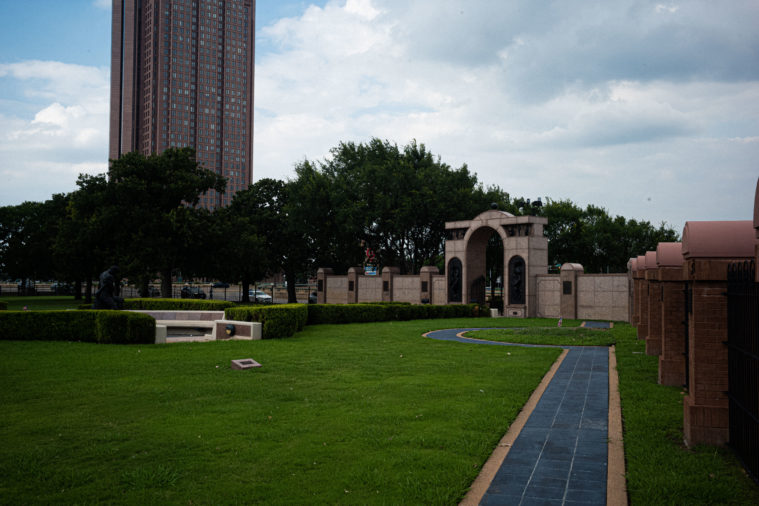The Freedman’s Memorial Cemetery is empty on a sweltering weekday in June, the gated park tucked between Lemmon Avenue and Calvary Street contained by the three-lane frontage road that edges the moat of the North Central Expressway. The sound of traffic dominates the space—a dull, uneasy roar, the sound of an industrial fan, an airplane landing.
An arresting, life-size bronze sculpture of an African woman—the Prophetess, the keeper of memory—stands at the entrance. She holds a harp in her left hand, her right palm open and extended outward in invitation.
In 1869, a group of freed slaves purchased an acre of land on what was then the outskirts of Dallas for $25. The land included what had been a slave cemetery. As other Freedmen settled around the cemetery and purchased more land, they established a thriving community, one of numerous Freedmen’s Towns spread across Dallas. It was a place of hope and growth, counting seven churches, many of which hosted day schools and, later, a high school. Black doctors and dentists set up shop here. Black-owned grocers and movie theaters opened. And Black families interred their relatives at the cemetery, which eventually grew to cover 4 acres.
On August 12, 1946, the Dallas Morning News reported that the state highway department would embark on the city’s first freeway, “a project that promises much relief for Dallas’ traffic congestion.” The Central Expressway would be built along the original route of the Houston and Texas Pacific Railroad but would also be built over a large portion of the cemetery, along with more than 1,500 structures, most of them owned or occupied by Black families who were descendants of the original Freedmen. “It is hoped that no unwarranted delay in the removal of tenants and city-owned houses will upset the schedule in beginning this work,” the newspaper reported. It didn’t seem to matter that the cemetery was in the road’s path. “Black graves were simply paved over, headstones used as rubble to help fill ditches and low spots,” a Dallas Observer columnist wrote in 1999.

The new road opened in 1949. Within a decade, traffic congestion had returned. In 1987, after the state highway agency announced its intention to expand the 10-mile stretch of highway, an archaeologist working for the department did a survey in the neighborhood and noticed a sign for “Freedman’s Memorial Park.” The project was stopped and archaeologists started digging.
One body was found. Then 30. Then 1,157.
Eventually, the team concluded that the construction of the original expressway had paved over roughly a fourth of the cemetery that once held the remains of nearly 7,000 slaves and Freedmen and “virtually eliminated all physical above-ground reminders” of its presence. In 1993, the newly renamed Texas Department of Transportation painstakingly exhumed the remains from under the road and reinterred them at the park, alongside thousands of other unmarked graves.
While highway engineers drew up expansion plans for the road—proceeding over the former gravesites—the City of Dallas commissioned Black sculptor David Newton to build a memorial honoring the desecrated graves. “My primary theme for the project was telling the whole African American genesis, from freedom in Africa to enslavement and then to emancipation here in the United States,” said Newton at a virtual panel convened by Brown University this April titled “This Is America: Memorializing Black Death.”
Newton envisioned the memorial as a collective headstone for the thousands who had been lost to the highway’s construction. From a bird’s-eye view, it appears in the shape of a cross, etched across the cemetery in perpendicular black-tiled pathways. In the memorial’s sunken center, an emancipated couple embrace, kneeling with their heads together, their gazes downward, considering their uncertain future.
The memorial was dedicated in 1999. A year later, the highway expansion was completed. Today, 184,000 cars shuttle north and south along the highway daily, a monument to forward motion. Car travel has, since the beginning, been cast toward the future. Speed over stillness, expansion over reparation, breadth over depth. The cities that cars created become forgetful, too, ignorant of the lives that came before. Across the Central Expressway, visible to the Prophetess standing at the cemetery entrance, is the flat skyline of a strip mall crowded with big-box retailers—Ross Dress for Less, Famous Footwear, Target. Placeless convenience that can exist only by forgetting what came before, a kind of cultural clear-cutting.
Emma McCune was born enslaved on June 29, 1855, and died from breast cancer 48 years later, on May 5, 1903, as a free woman. Hers was one of two headstones that were excavated intact from the rubble under the road. It’s displayed, set in pink marble, in the center of the memorial, with the inscription: “Gone from our homes but not from our hearts.”
The post Forgetful City appeared first on The Texas Observer.
